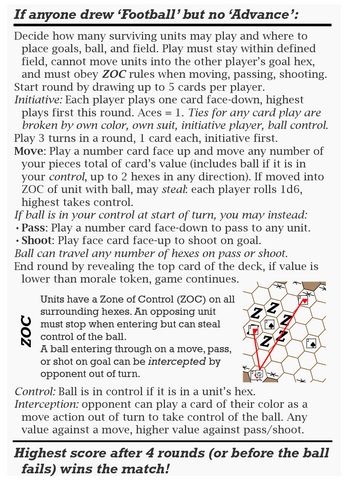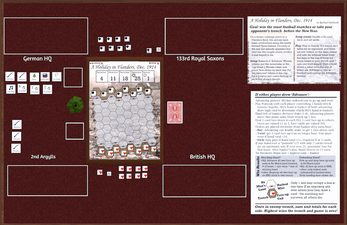A Holiday in Flanders, Dec. 1914
A downloadable game
On a frozen cabbage patch in a Flanders field, two armies have been entrenched along the newly formed Ypres Salient. It's early in the war but already apparent this won't be the couple month conflict it was hoped to be. Each player represents one side of the conflict, the British Expeditionary Force and the 2nd Argylls Scots Highlands unit within, and the German Imperial Army and her 133rd Royal Saxons regiment.
Christmas is coming, as is a New Year and rotation off the front to a warm billet in town -- if you can survive until then. Pass the time with your opponent by battling over No Man's Land. British and German command will push your luck to advance on the enemy trench, or maybe both sides will agree to put the guns down for a minute and battle it out on the world's most dangerous football pitch.
—
Designer’s Notes
This game is based on the myth and history of the Christmas Truce of 1914 or rather, the many smaller, informal truces that took place across the Western front that month. Pope Benedict XV, recently ascended to the position, was unsuccessful in brokering an official truce between the powers. (Philpot, 2014). In its place, individual soldiers on either side of the trenches enacted their own peace overtures. Where the trenches were close together, tins of bully beef, chocolates, jam, or biscuits would be tossed over each side. At night, British ‘Tommy’s’ could hear the ‘Jerries’ talking or singing, and would respond in kind, ‘Stille nacht’ competing with ‘The First Noel’ and other caroles (Dash, 2011). Stories of fraternization passed down the line and either were or were not condoned by the officer corps, depending on who is telling the story and when. A common story is that in the New Year, both the British and German Army came down hard on fraternization, the British saying infractions would be courtmartialed for treason, and the Germans the same, although little evidence can be found that either outcome occurred (Crocker, 2015). In fact, it is most likely that the officer corps, and specifically the junior officers on the front line, were okay with the amicable situation this month (Crocker). While there was no official truce, individual cease fires allowed the men on either side of the front to bury their dead and refortify their trenches without the worry of sniper or artillery fire. “Live and let live” never officially came from either headquarters, but from the field command it was given on a situational basis.
Whether or not an organized football game took place is another story. The particular regiments named in this game, the 2nd Battalion Argylls and Sutherland Highlanders of the British Army and the German Army’s 133rd Royal Saxon Regiment of the XIX (2nd Royal Saxon) Army Corps, are historically identified as the participating combatants of an organized football match during the truce time (Adams, 2015). Adams’ case study of the artifacts and stories surrounding this game provides evidence that it is probable that ‘a’ football match occurred, but not in the organized manner of the popular imagination, such as the Sainsbury’s Christmas 2014 video advert, “1914,” (Ledwidge, 2014) released during the centenary remembrances of the war’s start. Rather, it was likely that a ‘kickabout’ would occur if a football turned up, as the game was a common past-time on either side. The 133/Saxons had an official team at home and even gave Lieutenant Stewert of the 2/Argylls a photo of their pre-war team in trade for a tin of bully beef (Adams, figure 3 reproduced below).

This game takes on the micro-myth (Adams; Vamplew) of the Christmas Truce and its famous Football Match and plays it out in a satirical fashion.
On this battlefield, war is a game of chance with the odds stacked against you. Advancing on the enemy trench is represented by playing a version of Pontoon, the British version for Vingt-un (Twenty-One), pontoon either Tommy’s mangling of the French name or by Parlett’s account “as there is no normal process by which a V becomes a P, we may suspect the intrusion of some sort of jocular association with a temporary device for crossing a river. In other words, the officers played Bridge, while the ‘poor bloody infantry' had to make do with a pontoon” (Parlett, 2023). The banking game is stacked against the infantry, with each side’s HQ playing as Banker and every player playing against each other as well as the Bank. Your enemy has two hands against your one. Your very lives are at stake, but if the bank wins maybe you’ll make it to the other trench and win as well. Lose the hand to your opponent, however, and the blast from the their defense will bring chaos over No Man’s Land as your opponent picks up your pieces and drops them from above to land face up, dazed but alive, or face down, to later be planted in the fields.
Morale is deteriorating, so you’ll receive gifts from home, maybe tobacco from a Princess, or a deck of playing cards purchased to support the war effort at home. Not every order can be an advance. And sometimes, sometimes it’s the precious gift of a football, for the past-time has been taken up by soldiers in every town on the front line, particularly for these two combatants for whom the game was important before the war.
As the myth of the ‘Football Match’ was amplified by the centennials of the start and end of the war, overtaking the story of the Christmas Truce(s) altogether, football is played out as the real battle game of tactics, maneuver, aim, and control. Clear the field of bodies, define your goal posts, and take the field in a light, card-driven wargame. It won’t last forever - if you’re lucky the ball is new from home, but more often than not, it’s old, and well used, or a dodgy conglomeration of sandbag, paper, and twine.
The game is best played as originally designed and presented, as a ‘Postcard from the Front’ cut into small pieces and delicately moved across a rather small hex field. The counter density is low, no stacking is allowed, but the counters themselves are resistant to maneuver.
Play via Tabletop Simulator. Dropping counters doesn't work great, but if you set your piece height as high as possible and hit flip as you let go for each token, you'll get an approximation of the real play.
—
References
Adams, I. (2015) A Game for Christmas? The Argylls, Saxons and Football on the Western Front, December 1914, The International Journal of the History of Sport, 32:11-12, 1395-1415, https://doi.org/10.1080/09523367.2015.1082084
Crocker, Terri. (2015). The Christmas Truce: Myth, Memory, and the First World War. The University Press of Kentucky.
Dash, M. (2011). The Story of the WWI Christmas Truce. Smithsonian Magazine, December 23, 2011. https://www.smithsonianmag.com/history/the-story-of-the-wwi-christmas-truce-11972213/
Imperial War Museums. Voices of the First World War: The Christmas Truce. retrieved online April 3, 2023. https://www.iwm.org.uk/history/voices-of-the-first-world-war-the-christmas-truce
Ledwidge, R (Director). (2014). 1914 [Film]. Sainsbury's https://www.youtube.com/watch?v=NWF2JBb1bvM
Partlett, D. (2023). Historic Card Games, Blackjack. https://www.parlettgames.uk/histocs/blackjack.html
Philpot, T. (2014). World War I's Pope Benedict XV and the pursuit of peace. National Catholic Reporter, July 19, 2014 https://www.ncronline.org/news/justice/world-war-pope-benedict-xv-and-pursuit-peace
Vamplew, W. (2014). ‘Exploding the Myths of Sport and the Great War: A First Salvo’, The International Journal of the History of Sport 31.18 (2014): 2297-2312. https://doi.org/10.1080/09523367.2014.907598
Further reading for myth or history:
National WWI Museum and Memorial. The Christmas Truce, Winter 1914. http://exhibitions.theworldwar.org/christmas-truce/
Brown, Malcolm (Director). (1981). Peace in No Man’s Land. [Film]. BBC Productions.
Hill, M. (2021). Christmas Truce by the Men Who Took Part: Letters from the 1914 Ceasefire on the Western Front. Fonthill Media.
Moore, Nich. (2014) Blackjack In The Trenches Of World War One. Blackjack Champ. https://www.blackjackchamp.com/news/blackjack-in-the-trenches-of-world-war-one/
Slayton, N. (2022). The complicated truth about the famous ‘Christmas Truce’ of World War I. Task & Purpose. https://taskandpurpose.com/history/christmas-truce-world-war-1-history/
Weintraub, S. (2002). Silent Night: The Story of the World War I Christmas Truce. Plume. Williamson, Henry. (1970). The Christmas Truce. in History of the First World War, vol. 2, no.4, edited by Barrie Pitt. Purnell. Reprinted online at https://www.henrywilliamson.co.uk/hw-and-the-first-world-war
—
Credits
Design and layout by Richard Eberhardt
This work is licensed under a Creative Commons Attribution-ShareAlike 4.0 International License. Two elements are outside of this license and are used under the doctrine of fair use.
Photo used for game map background:
© IWM Q 108926 “View from behind British lines towards Mount Kemmel in the Ypres area, ca. January 1915.” https://www.iwm.org.uk/collections/item/object/205351659
Postcard photo used for cover image:
"The First Trench at Ypres" (photographer and date unknown, but likely 1914 or 1915) http://thebignote.com/2016/11/03/the-first-trench-at-ypres/
Photograph of the 133 Royal Saxon Regiment pre-war football team, from The Argyll and Sutherland Highlanders Museum, Stirling Castle. https://www.researchgate.net/publication/283770898_A_Game_for_Christmas_The_Argylls_Saxons_and_Football_on_the_Western_Front_December_1914/figures?lo=1
| Status | In development |
| Category | Physical game |
| Rating | Rated 5.0 out of 5 stars (1 total ratings) |
| Author | Rik Eberhardt |
| Tags | cards, Football, pftf2023, postcard-jam, trench, wargame, ww1 |
Download
Install instructions
Print this double-sided to cardstock. Cut out on the solid lines so you end up with a card with the hex map and setup rules, a card with the Advance and Football rules, and a series of Morale and unit tokens. You'll need 2 six-sided die (1 per player) and a standard 52-card poker deck to play.
Development log
- Update: you can steal control of the ball now!Apr 07, 2023






Leave a comment
Log in with itch.io to leave a comment.